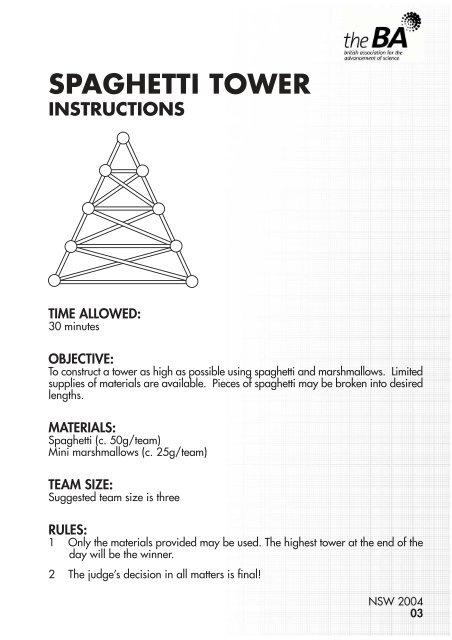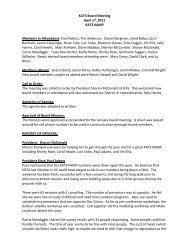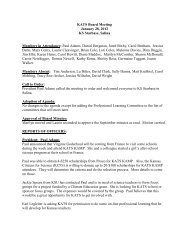Spaghetti Tower Instructions - KATS
Spaghetti Tower Instructions - KATS
Spaghetti Tower Instructions - KATS
Create successful ePaper yourself
Turn your PDF publications into a flip-book with our unique Google optimized e-Paper software.
SPAGHETTI TOWER<br />
INSTRUCTIONS<br />
TIME ALLOWED:<br />
30 minutes<br />
OBJECTIVE:<br />
To construct a tower as high as possible using spaghetti and marshmallows. Limited<br />
supplies of materials are available. Pieces of spaghetti may be broken into desired<br />
lengths.<br />
MATERIALS:<br />
<strong>Spaghetti</strong> (c. 50g/team)<br />
Mini marshmallows (c. 25g/team)<br />
TEAM SIZE:<br />
Suggested team size is three<br />
RULES:<br />
1 Only the materials provided may be used. The highest tower at the end of the<br />
day will be the winner.<br />
2 The judge’s decision in all matters is final!<br />
NSW 2004<br />
03
SPAGHETTI TOWER<br />
BUILDING HINTS AND TIPS<br />
There are many ways of building towers using spaghetti and marshmallows. These<br />
notes are intended not as instructions, rather as points to think about in developing<br />
the design.<br />
TOP TIPS!<br />
1. Make sketches of any good ideas you have and make plans for how you will<br />
construct the tower – good planning and design are essential to building a<br />
successful tower!<br />
2. Where you choose to use shortened pieces of spaghetti, make sure you cut<br />
them accurately. If you don’t use pieces of equal length in a particular section<br />
of the tower, it may start to twist and topple.<br />
3. Use shorter pieces of spaghetti or put in braces (triangular supports) to help<br />
support squares or rectangles in your tower.<br />
4. Think carefully about whether the spaghetti should pass all the way through<br />
the marshmallow, or not…… Remember that the strength of a joint is dependent<br />
on how well the marshmallow can ‘grip’ the spaghetti strand without it slipping.<br />
5. There will be most stress at the base of the tower – think about how to add<br />
strength here.<br />
NSW 2004<br />
04
SPAGHETTI TOWER<br />
BUILDING HINTS & TIPS - more detail<br />
1. THE BUILDING MATERIALS<br />
Although spaghetti and marshmallows don’t seem like strong building materials, you can<br />
build surprisingly elegant and sturdy structures using them. The spaghetti provides the<br />
framework and support for the tower, the mini-marshmallows are used to make connectors.<br />
The important thing to realise is that the marshmallows “grip” onto the pieces of spaghetti<br />
to hold the joints in place. The strength of a joint is dependent on how well the marshmallow<br />
can hold the spaghetti strands without them slipping. If there is a heavy load (weight) on<br />
the joint it may cause the marshmallow to “creep” or change shape until the joint fails -<br />
this is most likely to happen where the load is the greatest, i.e. at the bottom of the tower.<br />
2. MAKING STRONG SHAPES<br />
The shapes that are used to build strong structures are very important. Think about the<br />
shapes that have been used to construct bridges and towers that you have seen or know<br />
about. Start to practice building with spaghetti and marshmallows by testing out different<br />
basic shapes such as squares and triangles. You will discover that squares collapse easily<br />
under compression. Four pieces of spaghetti joined in a square give way at their joints –<br />
the weakest points. But, if you make a spaghetti triangle, the situation changes. To make<br />
the triangle collapse you have to push very hard. You can build very large structures from<br />
squares and cubes, but they will be weak and will usually fall down quite easily. If you<br />
try to make a structure out of triangles and pyramids, it will be strong but you will use a<br />
lot of materials before the tower gets very tall! The best way to build a tall tower is to use<br />
both triangles and squares – that way you can build big structures that are less wobbly.<br />
A diagonal piece of spaghetti put across a square turns a square into two triangles and<br />
makes it more rigid.<br />
3. COMPRESSION AND TENSION – SOME BASIC PRINCIPLES<br />
Even though a tower you build may be standing perfectly still, the individual parts are always<br />
pushing and pulling on each other. Large structures remain standing because some parts are<br />
being pulled or stretched (tension members) at the same time as others are being pushed or<br />
squashed (compression members). The vertical pieces of spaghetti in your tower will be in<br />
compression, and the compression will be greatest at the base of the tower. The horizontal<br />
and diagonal pieces of spaghetti in the tower may be in tension. The strength of these tension<br />
members will not depend on how strong the spaghetti is, but on how well the marshmallows<br />
can grip it (and hold it in place). The marshmallows are most likely to change shape and fail<br />
at the bottom of the tower, where there is most weight on them (from the compression and<br />
tension members).<br />
N.B. To make this challenge slightly easier the race organiser could provide a small<br />
number of LARGE (e.g.four per team) marshmallows to incorporate into the base of<br />
the tower.<br />
NSW 2004<br />
05
Here are some examples










